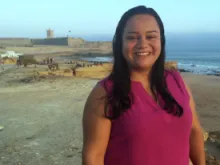
I’m a biological oceanographer and a marine biogeochemist at the National Oceanography Centre (UK), interested in biophysical interactions and the biological carbon pump.
- I use data from underwater gliders as well as other autonomous platforms, satellite remote sensing and shipboard oceanographic data to understand how water column dynamics affect phytoplankton and consequent carbon export.
- I use high resolution data from gliders to look at mixed layer depth dynamics and the role it plays in controlling the phytoplankton population, with a large focus in polar ecosystems.
- I’m interested in using and developing new methods to use autonomous platforms and integrated ocean observatories to answer ecosystem-wide questions.
- I’m an active member of the Oceangliders Steering Committee and a member of the Science Advisory Group (SAG) for the Future Marine Research Infrastructure programme.
- Since November 2024, I'm a Chief Scientist for Marine Autonomy Robotics Systems (MARS) group aiming to strengthen the links between the marine science community and engineering/technology.
I’m currently working on several projects leveraging marine autonomy to understand and quantify the role of biology (biological carbon pump) and ocean physics in the carbon cycle:
- ReBELS (lead PI): Resolving Biological carbon Export in the Labrador Sea
- PARTITRICS (WP1 lead): PARTIcle Transformation and Respiration Influence on ocean Carbon Storage
- IDAPro (NOC PI): Integrating Drivers of Atlantic Productivity
Upcoming projects:
- POLOMINTS (WP2 lead): Polar Ocean Mixing by Internal Tsunamis
Previous projects at NOC:
- ERC GOCART (Gauging ocean Organic Carbon fluxes using Autonomous Robotic Technologies)
- NERC COMICS (Controls over Ocean Mesopelagic Interior Carbon Storage)
- NERC CUSTARD (Carbon Uptake and Seasonal Traits in Antarctic Remineralisation Depth)
- NERC BIARRITZ (Bridging International Activity and Related Research Into the Twilight Zone)
- Horizon2020 TechOceanS (Technologies for Ocean Sensing)
For an up-to-date list of my ps check out my google scholar profile.
You can also find me on ORCiD and ResearchGate.
at NOC:
- Arctic WG member
- Autonomy WG lead
National:
- Future Marine Research Infrastructure (FMRI), Science Advisory Group (SAG)
International:
- OceanGliders, Steering Committee member
- Voice of the Ocean (VOTO), Scientific Advisory Committee member
- Guidelines and best practices for using OOI biogeochemical sensor data, Working Group contributor
- Atlantic Observatory – Data and Monitoring Infrastructure project, Advisory Board Panel member
Past projects:
GOCART
GOCART will use AUVs to investigate seasonal and high frequency variability in organic carbon fluxes and remineralisation. Glider deployments will be used to establish the characteristics and significance of temporal variability in organic carbon flux and remineralisation depth. This will give new insights into the factors driving variability in remineralisation depth, ultimately leading to development of a new model parameterisation incorporating temporal variability.
COMICS
COMICS (Controls over Ocean Mesopelagic Interior Carbon Storage) aims to quantify the flow of carbon in the ocean’s ‘twilight’ zone in order to more accurately model global climate change. We have had two expeditions to two fascinating sites: The Benguela Upwelling off the coast of Namibia and the Southern Ocean around South Georgia. By studying these two contrasting environments, we can better understand what drives ocean carbon storage.
CUSTARD
CUSTARD (Carbon Uptake and Seasonal Traits in Antarctic Remineralisation Depth)will examine how seasonal changes in food availability for phytoplankton at a key junction of the global ocean circulation influences how long carbon is trapped in the ocean rather than escape to the atmosphere as carbon dioxide.